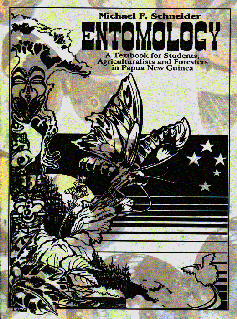Entomology
- Insect Collection of Bulolo University College, Papua New Guinea
- Binatang – A Pictorial Catalogue of Papua New Guinea’s Insects; Interactive CD-ROM
Michael F. Schneider (1999):
ENTOMOLOGY – A Textbook for Students, Agriculturalists and Foresters in Papua New Guinea; Bulolo University College; Training Manual No 19; ISBN 9980-85-259-3; 312 pp., 11 colour plates
Features of this book:
- the first Entomology book produced for PNG

- addresses students as well as professionals of science, agriculture and forestry
- most examples taken from PNG’s insect fauna
- more than 60 pages on insect orders
- includes eleven colour plates
- more than 220 figures illustrating the text
- further reading suggestions for each chapter
- includes about 350 references
- more than 1,200 terms explained in the glossary
- cross-references and index included for the convenience of the reader
- comprehensive list of forest insect pests of PNG
- includes appropriate, low-ecological impact control measures for forest insect pests
pdf-files of this book can be viewed (downloads between 200 KB and 1 MB)
Table of Contents
Preface IV
Acknowledgements VI
Remarks on Scientific Names and Terms VIII
5. Evolution and Classification
5.1 Phylogeny of Insects 78
5.2 Fossil History 79
5.3 Taxonomy and Classification 79
5.4 Identification of Specimens 81
5.5 Synopsis of the Animal Phylum Arthropoda 81
5.5.1 Subphylum Chelicerata 82
5.5.1.1 Order Araneae (True Spiders) 82
5.5.1.2 Order Acari (Acarina: Mites, Ticks) 83
5.5.1.3 Order Opiliones (Harvestmen) 86
5.5.1.4 Order Scopriones (Scorpions) 86
5.5.1.5 Order Pseudoscorpiones (Pseudoscorpions) 87
5.5.1.6 Order Pedipalpi 87
5.5.2 Subphylum Mandibulata 87
5.5.2.1 Class Chilopoda (Centipedes) 87
5.5.2.2 Class Progoneata (Millipedes) 87
5.5.2.3 Class Entognatha 88
5.5.2.4 Class Insecta (Insects) 89
5.6 The Insect Orders 90
5.6.1 Simple Key to Insect Orders 90
5.6.2 Synopsis of Insect Orders 92
5.6.3 Outline of Insect Orders 92
5.6.3.1 Archaeognatha (Bristletails) 92
5.6.3.2 Thysanura (Silverfish, Firebrats) 93
5.6.3.3 Ephemeroptera (Mayflies) 93
5.6.3.4 Odonata (Damselflies and Dragonflies) 94
5.6.3.5 Plecoptera (Stoneflies) 94
5.6.3.6 Blattodea (Cockroaches) 95
5.6.3.7 Isoptera (Termites) 96
5.6.3.8 Mantodea (Praying Mantids) 97
5.6.3.9 Grylloblattodea (Ice Crawlers) 97
5.6.3.10 Dermaptera (Earwigs) 98
5.6.3.11 Orthoptera (Crickets, Katydids, Grasshoppers and Locusts) 98
5.6.3.12 Phasmatodea (Stick and Leaf Insects) 100
5.6.3.13 Embioptera (Web- or Footspinners) 101
5.6.3.14 Psocoptera (Booklice, Barklice; Psocids) 101
5.6.3.15 Zoraptera 102
5.6.3.16 Phthiraptera (Lice) 102
5.6.3.17 Hemiptera (Aphids, Leafhoppers, Scale Insects, Lerps, Cicadas, True Bugs, etc.) 103
5.6.3.18 Thysanoptera (Thrips) 109
5.6.3.19 Megaloptera (Alderflies and Dobsonflies) 110
5.6.3.20 Raphidioptera (Snake-Flies, Camelneck-Flies) 110
5.6.3.21 Neuroptera (Lacewings and Antlions) 111
5.6.3.22 Lentilburgeroptera 112
5.6.3.23 Coleoptera (Beetles) 112
5.6.3.24 Strepsiptera (Stylops) 122
5.6.3.25 Mecoptera (Scorpion Flies, Hanging Flies) 123
5.6.3.25 Siphonaptera (Fleas) 123
5.6.3.26 Diptera (True Flies, Midges, Mosquitoes, Crane Flies, Sandflies, Gnats, Punkies) 124
5.6.3.27 Trichoptera (Caddis Flies) 132
5.6.3.28 Lepidoptera (Butterflies and Moths) 133
5.6.3.29 Hymenoptera (Sawflies, Wasps, Bees and Ants) 147
5.6.4 Literature on the Identification of Insects 154
Color Plates 1 – 6
Color Plates 7 – 11
6. Forest Insect Pests and their Signs
6.1 Insect Damage and Sign Categories 159
6.1.1 Leaf Damage 159
6.1.2 Seed and Cone Damage 160
6.1.3 Shoot, Twig, Trunk and Root Damage 161
6.1.4 Insect Signs 162
6.2 Common Forest Insect Pests of Papua New Guinea 162
6.2.1 Termite Pests 174
6.2.2 Orthopteran Pests 182
6.2.3 Hemipteran Pests 182
6.2.4 Dipteran Pests 184
6.2.5 Coleopteran Pests. 184
6.2.6 Lepidopteran Pests 192
6.2.7 Hymenopteran Pests 197
6.3 Forest Insect Pests of other South Pacific Countries 198
